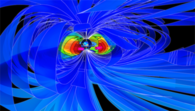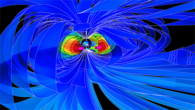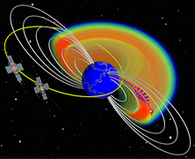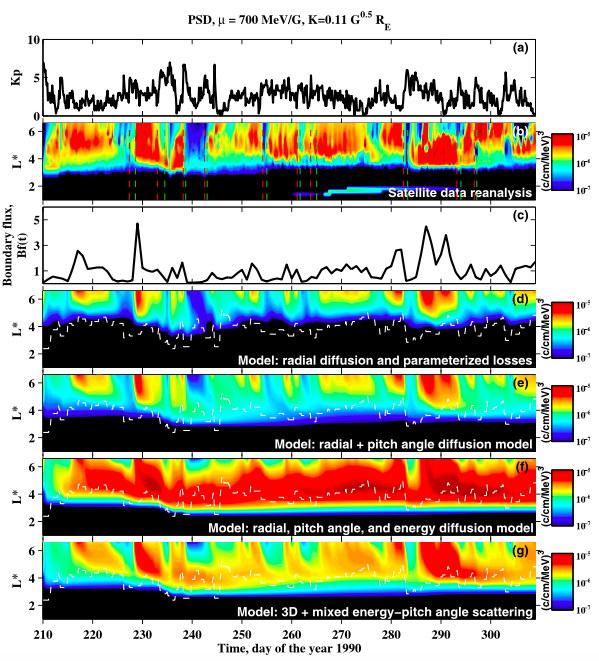A new way to create Saturn's radiation belts

November 29, 2018
Around Saturn, and other planets including the Earth, energetic charged particles are trapped in magnetic fields generated by the planets. Here the particles arrange in doughnut-shaped zones, known as radiation belts, such as the Van Allen belts around the Earth where electrons travel close to the speed of light.
How do electrons vanish from the Van-Allen-Belts?

December 21, 2017
Super fast electrons are pushed into the atmosphere whereas less fast electrons stay – Findings are important for satellite safety and exoplanet studies.
Wave-induced loss of ultra-relativistic electrons in the Van Allen radiation belts

1. Oktober 2016
A geomagnetic storm on January 17, 2013, provided unique observations that finally resolved a long-standing scientific problem.
A perfect sun-storm
September 28, 2016
A geomagnetic storm on January 17, 2013, provided unique observations that finally resolved a long-standing scientific problem. For decades, scientists had asked how particles hitting the Earth's magnetosphere were lost. A likely mechanism involved certain electromagnetic waves scattering particles into the Earth's atmosphere. More recently, another mechanism was proposed that caused particles to be lost in interplanetary space. Yuri Shprits from the GFZ German Research Centre for Geosciences and the University of Potsdam, together with colleagues from several institutions, recently found that both mechanisms play a role affecting particles at different speeds. “This study resolves some fundamental scientific questions about our space environment and may also help understand fundamental processes that occur elsewhere in space, on the Sun, in outer planets, distant galaxies, and exoplanets,” says Yuri Shprits. He adds: “This study will also help us predict and now-cast the space environment and protect valuable satellites in space.” The study appeared in Nature Communications on Wednesday, September 28.
Radiation Belt Modelling
Earth’s radiation belts consist of highly energetic protons and electrons trapped by Earth’s magnetic field in the region of 1.2~8 Re (Earth radii) away from Earth’s center. Highly energetic protons mainly distribute in the inner radiation belt, which typically locates 1.2~2.5 Re away from geocenter. The inner radiation belt is relatively stable, while the outer radiation belt is highly dynamic, which exhibits dramatic variability over timescales from minutes to hours. The inner and outer belts are separated by a slot region at around 2~3 Re where energetic particle flux levels are usually low. Highly energetic electrons in the Earth’s radiation belts are hazardous for satellite equipment.
To understand the dynamic evolution of outer radiation belt, physics-based 3D and 4D Versatile Electron Radiation Belt (VERB) codes are developed by our group. Important mechanisms controlling the dynamic evolution of radiation belts involve radial diffusion, local acceleration, local loss, magnetopause shadowing and electric convection. There are various plasma waves in the inner magnetosphere, such as whistler mode chorus waves, hiss waves, electromagnetic ion cyclotron (EMIC) waves and ULF waves. Wave-particle interactions play an important role in the processes of radial diffusion, local acceleration and local losses. To quantify wave-particle interactions between various types of waves and energetic electrons, bounce-averaged diffusion coefficients are calculated using our Full Diffusion Code (FDC). Then these diffusion coefficient can be utilized in the VERB code to solve the Fokker-Planck equation, which is capable of computing the 1D, 2D, 3D and 4D evolution of the Phase Space Density (PSD) of energetic electrons, as shown in Figure below.
The upper image shows the comparison of electron PSD modeled by the VERB code simulations with a multisatellite PSD reanalysis at µ=700MeV/G and K=0.11G0.5RE [Shprits et al., 2011]. From top to bottom: (a) Kp index; (b) multisatellite PSD reanalysis, dashed red and green lines indicate the beginnings of the main and recovery phase of storms; (c) flux variation used at the outer radial boundary of the code, obtained from the CRERES measurement; (d) the radial diffusion only model with losses parameterized as 5/Kp days outside of the plasmasphere and 5 days inside of the plasmasphere; (e) radial and pitch angle diffusion model; (f) 3-D radial, energy, and pitch angle diffusion; (g) 3-D simulation with mixed terms. The white curves show the calculated location of the plasmapause Lpp. [Subbotin et al., 2011].




